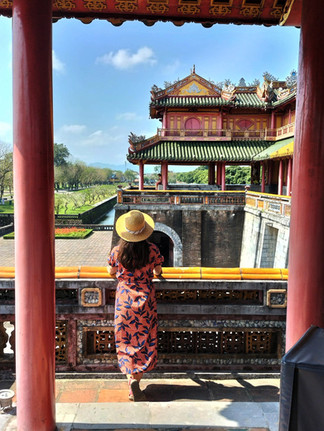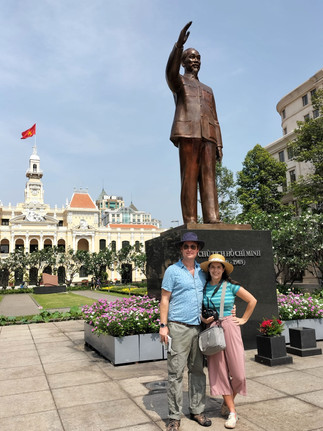What to pack for a trip to Vietnam in February
- teamthomastravels
- Mar 13, 2023
- 9 min read
Updated: Nov 7, 2023
Disclosure: this blog contains some gifted items and might include affiliate links that add no extra cost to you, but we might make a small commission from any sales made through them. Rest assured that we only recommend products that we love!
In our opinion, Vietnam's weather in February is the sweet spot. The worst of winter is over in the north with milder temperatures and light rain (although the far north, Sapa and beyond, will still be very cold and potentially wet and misty - best to save your trekking up there for another trip), while the south bakes in the 30+ degrees dry season.
Vietnam is a very long country and so has different weather throughout - if you're planning a backpacking trip from north to south or south to north you'll need to pack a range of clothes to cover all eventualities. Here is our helpful packing list for Vietnam in February based on what we took with us:

Hats
Sun hat - Vietnam is close to the equator and the sun is very strong. We would recommend taking a wide brimmed hat to shield your face and the back of your neck, preferably a collapsible one that you can stuff into your backpack. Bonus points if the fabric includes UV protection to further keep the sun off your head!
We also chucked a baseball cap in our bags for windy/active days like hiking or cycling, and for reading on the beach. It drives me potty when my wide brimmed sunhat means that I can't put my head flat on the beach while reading, but a cap still keeps the sun out of my eyes without getting in the way.
Sunglasses
Being so close to the equator, Vietnam is hot and blazing by about 9am. Save your eyes from UVA/UVB and avoid a headache with a pair of polarised sunglasses to deflect the glare. We swear by our Ray-Bans (I wear these), but David also loves his Tog24 pair for action days.
Shoes

While we didn't take our hiking boots on this trip, we made sure to pack comfortable walking shoes for all the city stomping we did. You could pack your favourite trainers, we love our travel shoes by UIN Footwear - the honeycomb insole is like walking on a cloud! Plus they come in a huge range of cool designs, and their slip on design makes them really convenient for airport security and going in and out of the many beautiful temples you'll be sure to visit in Vietnam - Buddhist temples usually require you to take your shoes off before entering. We own 4 pairs now and swear by them on our travels!
You can save £5 off a pair of UIN footwear shoes using our code: TravelCouple_UIN
We also took our walking sandals which are so versatile - they are cool and light to wear during the day, and the covered toe gives good protection when cycling, climbing stone steps or paddling on a rocky beach. David's are by Keen, mine are Karrimor.
You'll also want a pair of flipflops for the pool/beach.
Swimwear
Speaking of, you'll need to pack your swimmies for hotel pools and Vietnam's beautiful beaches. For a month long trip we packed 3 pairs so we'd have a few changes on adjacent days.
Warm/waterproof layers

Bear in mind you won't need these once you're south of Ninh Binh, so if you're only visiting central and south Vietnam, skip this step. However, if you're visiting Hanoi, Halong Bay and Ninh Binh, you'll want a thin warm layer that you can stuff into your backpack for the rest of the trip. We packed a light microfleece and a stuffable quilted down jacket, both from Decathlon, which packed away easily (You'll also need these for when you get back home, what a shock we had when we landed back in the UK in February temperatures!).
You might also want a beanie hat for the evenings, especially if you're going further north than Hanoi.
Raincoat - Ditto for the north, you'll want a light packaway kagool or raincoat that will roll up small. Ours are by Tog24.
Every day clothes
For any trip longer than 2 weeks, we'd recommend packing half as many clothes as days you're travelling and finding a laundrette halfway through the trip. This stops you from overpacking your rucksack, keeps you within your weight allowance for internal flights, and stops everything from getting creased. For our 4 week trip we took 14 days worth of clothes and did a wash around the half way point.
Whatever you're taking, be it t-shirts, shorts, skirts, dresses or trousers, make sure that the fabric is light and breathable. Once you leave the north, Vietnam is hot and humid, so cotton is your best friend! David also likes to wear sporty t-shirts with wicking fabric like this one from Tog24 or a button up shirt worn open over a vest - he finds this to be much cooler than a t-shirt!
NB- covering up in Vietnam: It's worth noting that many places in Vietnam require your shoulders and knees to be covered (male and female), and as we found that we were visiting a temple, pagoda or historic site that asked for "polite and neat" clothing most days, it was easier to only pack clothes that covered up a bit more. I did pack a small amount of shorts for the beach, but otherwise I lived in longer cotton dresses and floaty trousers which were practical and cool.
Smarter options for cocktails
While we certainly didn't pack any dressier shoes, we included a couple of button up shirts/dresses that could also cross over into evening wear, in case of going to a nice cocktail bar or date night dinner. Choose things that roll up and don't crease easily, as they'll be spending most of the trip in your backpack!
Pyjamas
With the air conditioning cranked up in your hotel room you'll want PJs. Why not consider a pair that not only keeps you both warm and cool, but also keeps the mozzies away? We were gifted a pair of bamboo pyjamas from WeDrifters, infused with insect repellant - they were soft, stretchy and perfectly cool in the (non airconditioned) Muong stilt house we slept in in Cuc Phuong National Park. Plus I didn't get nibbled!
What bags to use for a backpacking trip in Vietnam
Main backpack
The most important piece of kit for your Vietnam trip is your backpack. We chose a 65 litre which was large enough for 2 weeks worth of clothes plus shoes, wash bag, beach towel etc, but not so big that you end up overloading yourself. While you might have a 23kg weight allowance on flights, you don't want to go anywhere near this as you'll have to carry it on your back! I think our bags weighed about 15kg once packed, which was comfortable to carry.

David uses the Mountain Warehouse Tor 65L and mine is the Eurohike Nepal . Both are really comfortable to wear and have lots of useful compartments and pockets. Make sure you adjust the straps to get a really good fit with the bag nice and close to your back and the weight balanced evenly.
For flights, we both used these travel duffel bags to protect the clips and straps on our backpacks during transit. They're strong, roomy, easy to chuck your backpack into before checking in and they pack down really small into a little bag that you can stash in your main backpack once you arrive.
Packing cubes
Packing cubes are one of those travel products that we never knew we needed, and now can't imagine packing without. They're the best way to organise your backpack and prevent things from getting creased as you can designate different cubes for tops, undies, dresses etc and it means that unpacking once you arrive at a hotel is as simple as taking cubes out of your bag and then putting them back in again. No more digging through your backpack for clean socks, creasing everything, or having to take everything out just to find your beach towel.
Rolling or folding your clothes into packing cubes helps to keep them neat and un-creased, plus most have a 2nd zip that compresses everything even flatter, which means you can fit more in your bag. There are loads of packing cubes available online, ours are from Bagail and we absolutely swear by them: you can see our little review blog here.
Carry on/day pack
You'll also want a small backpack for carrying onto the plane and using during the day. We both use the Osprey Daylite backpack and absolutely love it - it's roomy but compact, the padded shoulder straps are really comfortable, and if you want to take it hiking (we used it constantly on our USA honeymoon, including hiking all over Yosemite National Park and Zion National Park), it has a waist and chest strap, a back pocket that fits a platypus water bladder, and a loop on the shoulder strap to position the drinking hose over your shoulder for easy access while hiking.
Waterproof covers
Always useful in case of rain (especially for the tropics or let's face it, hiking in the UK), we have waterproof covers for both our big and small backpacks that can be stuffed into a side pocket and whipped out and fitted quickly when you need them.
Other useful things to pack:
Toiletries etc:
Sunscreen - go for factor 50, the sun is very intense in Vietnam and you'll definitely still get a tan, don't worry!
Bug spray
Loo roll - it was 50/50 on our trip whether or not public loos had toilet paper or not, so I had one in my day pack just in case!
Tampax etc - I saw sanitary towels/pads on sale everywhere in Vietnam but it was much harder to find tampons.
First aid kit - we always travel with a small first aid kit with plasters, anti bac wipes, tweezers, paracetamol, savlon etc, but for this trip we also added anthisan afterbite cream, antihistamine tablets (I'm allergic to mosquito bites and these really help to bring down the swelling!) and "starters and stoppers" as my mum calls them; let's face it, we all get a funny tummy at some point while travelling, whether it's being unable to go for a few days or going too often, and packing Loperamide Hydrochloride for diarrhoea and a gentle laxative for constipation will help ease any discomfort! We also pack Dioralyte rehydration sachets to replace fluids/electrolytes if we do get a bad tummy or heatstroke.
Essentials checklist:
Passport!! Check, check and triple check before leaving for the airport.
Printed copy of your VISA - even though Vietnam calls their visa an e-visa, you still need to print it off and have a paper copy to show at passport control. Apply via the official visa website well in advance - be aware that during public holidays like Tet (New Year celebrations), government offices can shut for several days and no visas will be processed during this time!
Currency - congratulations, you're a millionaire! Vietnam uses Vietnamese Dong which comes in bewilderingly high denominations - you'll be using 50,000, 100,000, 200,000 and 500,000 VND notes the most often. £1 is about 28,000 VND - when you order your currency try to get a good spread of notes, you don't want to arrive with a wad of 1000,000 VND bills and try to pay for a 35,000 lunch!
Money belt - a good way to keep your money safe is to carry it in different places on your person. We usually split it between us with a decent amount of it in money belts hidden under our clothes and a daily allowance in a wallet or purse. This means if someone clocks your wallet and pickpockets you, you only lose a small amount rather than everything. If you need to top up your daily allowance, do it discreetly in a toilet cubicle or similar so you're not flashing your money belt full of notes to everyone!
Camera Gear - whatever you usually use, I shoot with a Canon 2000D and we also have the Olympus Tough TG-5 which is a fab little camera! I use the FOSOTO shoulder bag during the day.
Pocketalk S translator - one of our favourite pieces of travel kit that we've used in several countries including Vietnam, Cambodia, France and Spain. While we always try to learn a few basic phrases while travelling, this handy gadget translates spoken word in real time, plus has a camera setting to translate text. We have a full review of it here.
Guide book - we love DK Eyewitness (beautiful pictures!) and Lonely Planet
Beach Towel - we have a sand proof one by Tesalate that's also really thin and light to pack.
Chargers and travel adapters - we found that Vietnam typically uses USA (2 vertical flat pins) and EU (2 vertical round pins) style plug sockets, so a multi region travel adapter will be really useful on your trip. We swear by the Rise ONE Universal travel adapter which covers over 150 countries - it has sliders to bring out the appropriate pins for different sockets, packs away really small into hand luggage and has 4 USB slots to charge multiple things at once.
Covid mask - yes it's 2023, but internal flights within Vietnam and Cambodia all required us to wear a face mask onboard. Airline depending, you might also need to wear one on your long haul flight to Vietnam as well.
Insulated water bottle - tap water is absolutely not drinkable in Vietnam, so you'll be buying a lot of bottled water. Try to cut down on single use plastic by buying big 5 litre bottles to keep in your hotel room and decanting them into a stainless steel bottle to use throughout the day. I found this one on ebay and was so impressed - not only is it 1 litre rather than the usual 500ml, but it keeps the water icy cold for HOURS, even in hot climates. I took it to the beach and the water was still just-out-of-the-fridge cold 8 hours later.
Entertainment for flights/buses - we took our Nintendo Switch, Kindle, UNO and a deck of cards. And don't forget headphones!
Heading to Cambodia next? You might find these blogs useful!
Save this post for later!




















